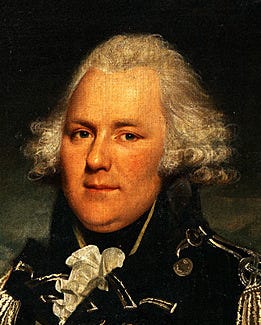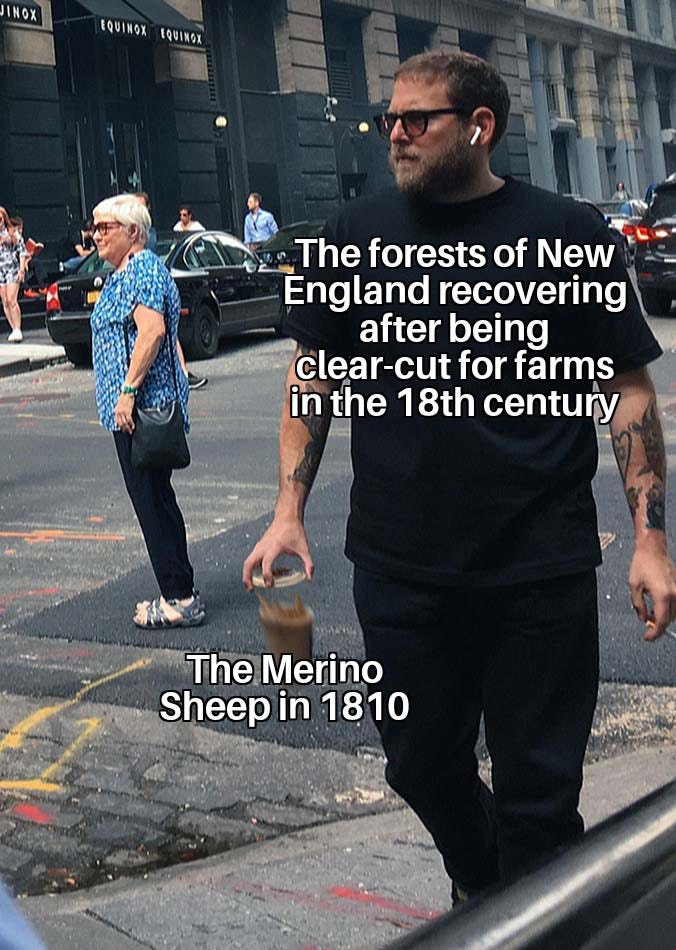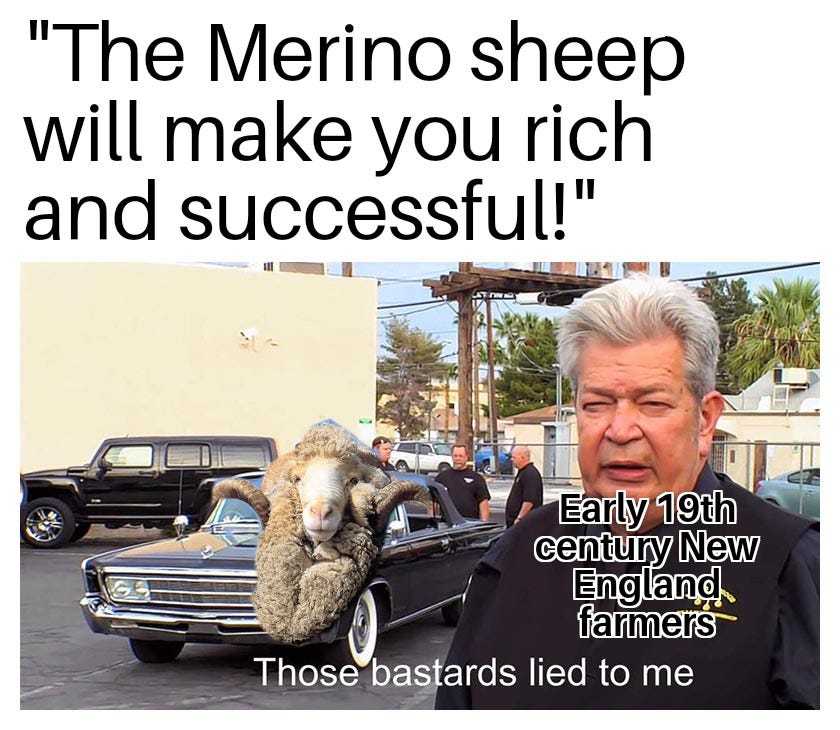From Riches to Rags: The Merino Sheep Craze of 19th Century New England
The story of how nearly all of New England's forests were destroyed over the course of three decades because of a war in Spain.
As a kid growing up in New England, one of the stories we were told about the old rock walls in the forests was that they were from the “Indians” who had once set property lines by stacking rocks. Of course, this wasn’t true, and as a young child it was confusing to try to figure out why they’d decide to go through all of the work of stacking rocks to make a wall in the woods. Again, this makes logical sense to a small child; the forests today have always been forests and if they had been cleared, how would they have returned to forest? As we got older, we realized they were relics from farmers marking property lines, which made a lot more sense, although the idea of building walls out of stone might seem like a weird choice. Turns out, there’s more to that story than we were ever told. Today we’re talking about a 35 year period in New England history, what’s called Sheep Fever, which took place from 1810-1845.

This three decade period was largely predicated on a handful of events that allowed for the massive explosion of Merino sheep in the United States. This period wasn’t just a great explosion of investment for profit in the rural northeastern United States, it was the first time in the new world where there was a market farming opportunity; not just subsistence. Pine tree clearcutting had been a necessary task demanded by the king 100 years prior, but those forests had since grown back to what many today recognize as a typical forest in the northeast. And of course, clearing the pine trees was less of a market opportunity and more of a “the king will have us killed if we don’t do it”.
So let’s talk about those handful of events. To fully understand what happened, we need understand how the newly arrived colonists understood the world they had arrived at. It was believed that there was an infinite amount of forest; you couldn’t cut it down fast enough, and much of the lands were quickly cleared, with many of the largest pines being claimed by King George for naval shipmasts. These were decreed to be property of the king, and it was demanded that all of the largest pines were shipped back to England.1
Pine is unique for 3 reasons; it grows straight with a main trunk and it’s incredibly strong, especially for its light weight. It also grows incredibly fast. This is the same reason we use pine for things like 2x4s in construction, and why homes at the time were also mostly built with pine. While unsurprising, many people didn’t care about the king’s proclamation and continued to cut the trees down at an incredible pace, while also sending some of the trees back to England, quickly clearing most of New England. The land was cleared both to make way for homesteads and small farms to ship foods back to Boston and New York as well as to feed the British navy’s fleet.
As farmers continued to cut deeper into the forests of the northeast and the country expanded west, farms also continued to move west, where the land was less rocky and what little topsoil had existed hadn’t been brutalized by tillage. The forests reclaimed abandoned farmlands, with few homesteads scattered in between. Ecologically speaking, this was what had happened in New England prior to the Merino sheep. 2
The Boston Brahmins
With all that said, we should change gears and talk a bit about the Boston Brahmins, because one Brahmin in particular was especially important for Sheep Fever; William Jarvis. The Brahmins are a relic of a time past that continues to influence the spheres of power in the United States, but once had far more power across the colonies. They came to the new world to establish a new English gentry, often coming from wealthier families in England hoping to increase their status by being the ‘new’ old gentry. 3
These are the same folks that brought you the Harvards of the new world, and were often descendants of some of the earliest settlers in the colonies, and part of that came with the ruthless prudence of people driven primarily by wealth. These folks are also, despite being literally a hundred or so families, many of the major players in the newly formed United States of America’s government. The Adams family, the Coolidge family, the Bacon family, the Cabots, the Chaffees, the Eliots, the Forbes, the Emersons, the Abbotts, the Delanos, and yeah, a lot of last names of folks who were president. You get it.
They believed it was their job to maintain the role of the aristocracy as it existed in England, that they would be community leaders, marry within their class, maintain social order through their exemplification of the gentleman, and so on. While some of these folks had earned money through business, most of it was through traditional aristocratic land ownership in England, and Brahmins who chose to venture into business with the goal of massive personal gain were considered uncouth and treated poorly by the others. The terminology stemmed from the Brahmins in India, which were considered the upper class, and the New England upper class was given the term in the 19th century.
Let’s talk about one specific member of the Brahmins, William Jarvis. Like many folks of new old money, Jarvis attended the best schools and went into business and also ended up repeatedly failing in business, burning through massive amounts of his fortune through his partners. But, you know, like money does, he was able to still buy a ship and and moved to Europe, where he dealt widely across the continent in commodities and built a successful trading house, William Jarvis & Co.
While he was using his family name overseas, he began to build a network across the seaboard of Europe, primarily in England, Spain, and Portugal, and saw merino wool selling far above the price of any other wool on the market. The wool, which could only be purchased from Spain, was getting $2 a pound, which might not sound like a lot for today— in today’s dollars the equivalent would be well over $50 a pound today, versus around $0.27 a pound for the sheep in my backyard. For a typical sheep, which produces about 10 to 15 pounds of wool, that’s about $600 a sheep, in today's dollars. A herd of 100 sheep would bring in a full-time income in today’s dollars, and that’s not even accounting for the meat production.
Now, being a well-connected man, his networking across europe earned him a position as a US consul because a family friend, Thomas Jefferson, just happened to be president. Jarvis held this position from 1802 to 1811, and it couldn’t have been better for him, as the perfect storm arrived.
The first patented sheep, The Merino Sheep (okay not technically speaking)
The Merino breed has three major theories of origins of how it was developed in Spain. Theories generally suggest that the Merino sheep is the product of hundreds of years of cross breed and importation from specific regions, either from Africa or from other parts of the Iberian peninsula.4 Genetic studies suggest that the Merino breed was likely the product of breeding a native sheep breed called the churro with a variety of rams from across the Mediterranean and Northern Europe over the course of hundreds of years.5 Regardless, these unique sheep were closely guarded for their fine, highly prized wool. Unlike most wool, it wasn’t scratchy while still being incredibly thick and productive. By the fourteenth century, the export of this luxurious fine wool was a booming business for the Spanish economy, and continued to be for the next 400 years.
Now I know I said that they were closely guarded, but they weren’t always. Sheep were given to royalty as gifts, where they were distributed from France to Prussia and Sweden. But for the average person, the export of Merinos from Spain was considered a crime that would be punishable by death. Unsurprisingly, some of these gifts were used for breeding and crossing, including the Germans in Saxony, who had up to four million Saxon Merino sheep by 1802.6 Needless to say, while the Spanish had by and large the largest population of Merino sheep, they were not alone, but those with access to developing their own herds was limited.
While the Merino sheep had managed to reach most of Europe and even Australia in 1797, it only managed to reach the United States in 1802, when Colonel David Humphreys, United States Ambassador to Spain, brought 91 Merinos, and later another 100 in 1808. Despite claiming the rights to being the first to bring Merinos to the United States, he was quickly outdone by William Jarvis in 1810. But let’s back up a bit.
Why the Merino Sheep?
It shouldn’t be a surprise, but sheep weren’t foreign in the colonies— people had raised various breeds for generations in the colonies. The dominant breeds, however, were mainly English. That doesn’t seem too bad, at first glance— they were used to cooler, wet climates. However, at that time, these sheep were known to be leggy and late maturing, and they often had low wool yields.
Being owned largely by subsistence farmers, these farmers were incapable of selectively breeding them at any meaningful scale, and were letting them breed simply in order to keep sheep on the landscape. While this created a sharp division between theirs and the English sheep, they were hardy and easily adapted to the harsh conditions in the colonies, which was of vital importance, and something that will be important later on. The key takeaway here was that sheep existed on the landscape with a very light footprint, and were not utilized on the basis of being economically significant.
Because of this, the bulk of the textile needs were supplied by trade with England and France. From the start of the colonies, England discouraged textile production in the Americas; keeping economic power in England was important to keeping the colonies from ever striking out on their own and allowed the English to have a guaranteed market to sell their products at great profit.
Even after the Revolutionary War, America did not have an industrial infrastructure for manufacturing cloth in the quantities needed. Despite this, because of the nation’s agricultural background coarse wool and cloth were always in demand. The little fine wool needed was imported, and the industry was never encouraged to grow in that direction as an economic device and continued to exist producing just enough for the bare minimum. However, things were beginning to change. Wealthy farmers such as George Washington and Thomas Jefferson saw the potential for sheep to become a profitable investment. Now it wasn’t just because suddenly sheep were valuable because they were suddenly seen to be undervalued. This was driven largely by escalations between their two predominant international trade partners, England and France, which provided a majority of that wool.
This ultimately escalated into the Embargo act of 1807, which blocked French & English processed wool from coming to American shores. And if there’s anything we know about embargos it’s that it fixes all your problems. Needless to say, things escalated. The next year, while Jarvis was still in Portugal, Napoleon invaded Spain.7 So now, not only was there no manufacturing sector to process wool to be sent to the US, but there was also a supply chain issue and border issues going on in Spain as one of their major processors, France, was currently attacking them.
So, what does a rich kid do? He networks and sets a plan in motion. 15,767 merino sheep arrived in numerous ports on the East Coast from Spain from 1810-11.8 In 1811, he steps down from his post and buys a farm in Weathersfield, Vermont, where he stays for the rest of his life. During this time, he helps farmers who want to raise merino sheep by selling them and travels to speak about the great opportunities available.
So, your first thought might be, awesome, he brought sheep, and he’s selling them instead of just keeping them all for himself, that isn’t all terrible, right? Well, let’s unpack the motivations for selling them instead of keeping them for himself. Not only had he been in the right place at the right time as the borders of Spain were no longer being protected, he continued to be at the right place at the right time. The first piece of this puzzle that created the perfect storm for the Merino sheep craze was that things continued to escalate between England, and the War of 1812 broke out, meaning more need for wool for socks for soldiers and so on. Additionally, whatever few things were getting into the United States were no longer available. Lastly, 2 years later in 1814, the power loom was invented, which were powered by dams on rivers, something the northeastern part of the United States was in no short supply of.
While he raises the Merinos himself, or at least owns the farm, he also invests heavily in textile mills. He’s created his own market and controls the processing of much of the wool, and as the new investors in Merino sheep begin to scale up their own production, the industry escalates exponentially. Central New England quickly explodes, becoming one of the largest producers of merino wool in the world.
Prior to the Merino sheep, only about 20% of the land below 2000 feet above sea level was agricultural land when the first Merino sheep were brought to New England. Within the 35 years, that switches to 80%. Of those nearly 16,000 sheep that arrived in 1810-1811, the population explodes to over 4 million by 1840.
The consequences of introducing this volume of sheep in this short of a time cannot be understated. Tom Wessels provides some significant insight into the magnitude of the landscape devastation that took place:
Over half the area of central New England was clear-cut to make way for sheep pasture. Now many people think that these stone fences were built as soon as farms were opened up and that’s not the case. Farmers much preferred wooden fences. They could put up ten times as much split rail zigzag wooden fencing a day as they could stone fencing. It’s only the massive deforestation associated with sheep fever; theres no longer enough wood to make wood fencing anymore and so farmers as those wood fences start to rot away have to go back to stone dumps and bring back the stone to make these stone fences. In central new England it’s estimated that we have over 125,000 miles of woodland stone fencing. That means if we lined it all up it’d wrap the equator five times it’s stretch more than halfway to the moon. I’ve calculated if we piled all this stone, it’d be six times as massive as all the pyramids in Egypt. And yet it was all done in just about 30 years.9
Now recall, these sheep had existed in other parts of the world; namely Germany and Australian. Further, as Spain was engulfed in war, they began to liquidate assets and sold off their prized merinos, and by 1844, between the influx in new Merino wool producers & the wars ending, the price drops from $2 a pound around 1809 to $.27 a pound in 1840. Most Merino farmers went under, leaving a landscape that had been clearcut and overgrazed in its wake. Of the nearly 4 million sheep that were in New England in 1840, only 2 million remained by 1860.10
The consequences of the clearcutting and overgrazing can still be seen today. Maine for example, which by and far is the least populated state in New England, only 1 half of a tenth of a percentage of the 18 million acres of forest has never been cleared since colonists showed up. Most of New England has fared even worse. Today, Maine is the most forested state in the country, with 90 percent tree cover. The condition of those woods is another matter, a question of quantity against quality. Unlike in old growth, repeatedly clear-cut forests (recall, this was not the first time the region had been clear-cut) send up homogenous stands of trees, both in terms of age and species. They’re less diverse and less resilient ecosystems, often favoring light-loving trees that would otherwise play only a minor role in the forest. These forests that were cut down in the drive for quick profits continue to echo throughout the landscape today. Driving through New England, the hillsides are littered with white pines, which would have traditionally existed in mostly disturbed areas, not as a main feature in the landscape.
If you live in New England today, you might notice that our forests are not by and large 150 years old; a second wave of Merino mania struck during the civil war as cotton became much harder to get in the north. What underscores these stories is the repeated willingness to allow economic decisions to leave lasting scars on our landscape, which becomes more and more damaging as other parts of our ecology become more brittle. With this in mind, it’s worth thinking about how stories like this speak to a larger issue of reciprocity with our landscape and the gifts that the ecosystems provide for us. As new opportunities for bubbles and wealth arise, whether that be in the form of another crop, commodity, or mineral, what can we learn from these practices in the past to be better, more humble stewards for the landscape around us.
If you’ve enjoyed this piece, which is equal to a 13 page chapter, of (so far) a 493 page book with 181 sources, you can support our work a number of ways. The first is by sharing this article with folks you think would find it interesting. The second is by listening and sharing the audio version of this content (which has not been released yet), the Poor Proles Almanac podcast, available wherever you get your podcasts. If you’d like to financially support the project, and get exclusive access to our limited paywalled content, you can subscribe on Substack or Patreon, which will both give you access to the paywalled content, and in the case of Patreon, early access to the audio episodes as well.
https://www.mainewoodlandowners.org/articles/the-kings-pines-the-colonies-and-the-revolution
https://www. youtube.com/watch?v=Vi12xaJxA5U
https://newenglandhistoricalsociety.com/brief-history-boston-brahmin/
Klein, J (1920). The Mesta: A Study in Spanish Economic History 1273–1836. Harvard University Press.
Ciani E, Lasagna E and D’Andrea M (2015). "Merino and Merino-derived sheep breeds: a genome-wide intercontinental study". Genetics Selection Evolution. 47 (64): 9–10. doi:10.1186/s12711-015-0139-z
Ross, C.V. (1989). Sheep production and Management. Engleworrd Cliffs, New Jersey: Prentice Hall.
https://www.history.com/this-day-in-history/french-defeated-in-spain
https://darntough.com/blogs/the-alternate-stitch/history-of-merino-wool
https://www. youtube.com/watch?v=zcLQz-oR6sw
https://newenglandhistoricalsociety.com/spanish-sheep-craze-that-forever-changed-vermont/









